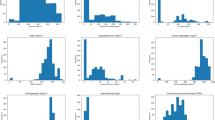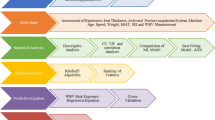Abstract
Machinery failure prognosis is one of the major tasks of condition-based maintenance in which the current issues of the machines are diagnosed, and the remaining useful life (RUL) is estimated by monitoring its present condition. This paper proposes a data driven approach for RUL estimation of rolling bearings. Health indicators (HI) of training bearing and test bearings are constructed by fusion of three features (semivariance, rms and variance) of the wavelet subband that has the maximum variance. Selection of the maximum variance subband helps in clear visualization of the fault progression with time. The dimensions of the selected features are reduced using principal component analysis. The dimensionally reduced features are then subjected to moving averaging over fixed window size and normalizing the moving average. By observing the run to failure degradation profile of training bearings, their respective failure thresholds are estimated. To estimate the failure thresholds of test bearing, HI of the test bearings are matched with the HIs of all the training bearings using bicubic interpolation and goodness of fit function. Support vector regression (SVR) models are used to predict the future degradation profile of test bearings and are constructed using HIs of the bearings. The failure threshold and SVR model finally predict the RUL of the bearings. PRONOSTIA data set is used for validation of the proposed algorithm. The prediction results are compared with some similar works on aforesaid dataset and have proved to be better in terms of prognosis evaluation parameters, viz. mean error, score and standard deviation error.

















Similar content being viewed by others
Availability of data and materials
The data and code may be shared if asked after publication.
References
Cubillo A, Perinpanayagam S, Esperon-Miguez M (2016) A review of physics-based models inprognostics: application to gears and bearings of rotating machinery. Adv Mech Eng 8(8):1–21. https://doi.org/10.1177/1687814016664660
Lei Y, Li N, Guo L, Li N, Yan T, Lin J (2018) Machinery health prognostics: a systematic review from data acquisition to RUL prediction. Mech Syst Signal Process 104:799834. https://doi.org/10.1016/j.ymssp.2017.11.016
Hong S, Tong V (2016) Rolling-element bearing modeling: a review. Int J Precis Eng Manuf 17:1729–1749. https://doi.org/10.1007/s12541-016-0200-z
Paris P, Erdogan F (1963) A critical analysis of crack propagation laws. J Basic Eng 85(4):528–533. https://doi.org/10.1115/1.3656900
Lei Y, Li N, Gontarz S, Lin J et al (2016) A model-based method for remaining useful life prediction of machinery. IEEE Trans Reliab 65(3):1314–1326. https://doi.org/10.1109/TR.2016.2570568
Wang J, Gao RX, Yuan Z et al (2019) A joint particle filter and expectation maximization approach to machine condition prognosis. J Intell Manuf 30:605–621. https://doi.org/10.1007/s10845-016-1268-0
Park Y, Cho S, Han J et al (2017) Fatigue life prediction of planet carrier in slewing reducer for tower crane based on model validation and field test. Int J Precis Eng Manuf 18:435–444. https://doi.org/10.1007/s12541-017-0052-1
Kumar S, Dasgupta K, Ghoshal SK (2019) Fault diagnosis and prognosis of a hydro-motor drive system using priority valve. J Braz Soc Mech Sci Eng 41:77. https://doi.org/10.1007/s40430-019-1572-7
Kumar A, Vashistha G, Gandhi CP, Tang H, Xiang J (2021) Sparse transfer learning for identifying rotor and gear defects in the mechanical machinery. Measurement 179:109494. https://doi.org/10.1016/j.measurement.2021.109494
Kumar A, Vashistha G, Gandhi CP, Tang H, Xiang J (2021) Tacho-less sparse CNN to detect defects in rotor-bearing systems at varying speed. Eng Appl Artif Intell 104:104401. https://doi.org/10.1016/j.engappai.2021.104401
Gebraeel N, Lawley M, Liu R, Parmeshwaran V (2004) Residual life predictions from vibration-based degradation signals: a neural network approach. IEEE Trans Ind Electron 51(3):694–700. https://doi.org/10.1109/TIE.2004.824875
Wu SJ, Gebraee NZ, Lawley MA (2007) A neural network integrated decision support system for condition-based optimal predictive maintenance policy. IEEE Trans Syst Man Cybern Part A Syst Hum 37(2):226–236. https://doi.org/10.1109/TSMCA.2006.886368
Pinedo-Sánchez LA, Mercado-Ravell DA, Carballo-Monsivais CA (2020) Vibration analysis in bearings for failure prevention using CNN. J Braz Soc Mech Sci Eng 42:628. https://doi.org/10.1007/s40430-020-02711-w
Chao L, Honggui H, Junfei Q, Cuili Y (2016) Design of a self-organizing recurrent RBF neural network based on spiking mechanism. In: IEEE 35th Chinese control conference (CCC) Chengdu, China. https://doi.org/10.1109/ChiCC.2016.7553916
Ha J, Kim H, Shin Y et al (2018) Degradation trend estimation and prognostics for low speed gear lifetime. Int J Precis Eng Manuf 19:1099–1105. https://doi.org/10.1007/s12541-018-0130-z
Benkedjouh T, Medjaher K, Zerhouni N, Rechak S (2016) Remaining useful life estimation based on nonlinear feature reduction and support vector regression. Eng Appl Artif Intell 26:1751–1760. https://doi.org/10.1016/j.engappai.2013.02.006
Sutrisno E, Oh H, Vasan A et al (2012) Estimation of remaining useful life of ball bearings using data driven methodologies In: IEEE international conference on prognostics and health management, Denver, CO, USA. https://doi.org/10.1109/ICPHM.2012.6299548
Guo R, Wang Y (2020) Remaining useful life prognostics for the rolling bearing based on a hybrid data-driven method. J Syst Control Eng. https://doi.org/10.1177/0959651820948284
Walid G, Hassen T, Mohamed L (2010) Support vector regression based residual control charts. J Appl Stat 37:309–324. https://doi.org/10.1080/02664760903002667
Mosallam A, Medjaher K, Zerhouni N (2013) Nonparametric time series modelling for industrial prognostics and health management. Int J Adv Manuf Technol 69:1685–1699. https://doi.org/10.1007/s00170-013-5065-z
Rasmussen CE (2004) Gaussian processes in machine learning. In: Bousquet O, von Luxburg U, Rätsch G (eds) Advanced lectures on machine learning. ML 2003. Lecture Notes in computer science, vol 3176. Springer, Berlin. https://doi.org/10.1007/978-3-540-28650-9_4
Padgett WJ, Tomlinson MA (2004) Inference from accelerated degradation and failure data based on gaussian process models. Lifetime Data Anal 10:191–206. https://doi.org/10.1023/B:LIDA.0000030203.49001.b6
Goebel K, Saha B, Saxena A et al (2008) A comparison of three data-driven techniques for prognostics. In: 62nd meeting of the society for machinery failure prevention technology, pp 119–131
Niknam SA, Kobza J, Hines JW (2017) Techniques of trend analysis in degradation-based prognostics. Int J Adv Manuf Technol 88:2429–2441. https://doi.org/10.1007/s00170-016-8909-5
Hong S, Zhou Z, Zio E, Hong K (2014) Condition assessment for the performance degradation of bearing based on a combinatorial feature extraction method. Digit Signal Process 27:159–166. https://doi.org/10.1016/j.dsp.2013.12.010
Nectoux P, Gouriveau R, Medjaher K, E. Ramasso E et al (2012) PRONOSTIA: an experimental platform for bearings accelerated degradation tests. In: Proceedings of international conference prognostic health management, pp 1–8
Nason GP, Silverman BW (1995) The stationary wavelet transform and some statistical applications. In: Antoniadis A, Oppenheim G (eds) Wavelets and statistics. Lecture notes in statistics, vol 103. Springer, New York. https://doi.org/10.1007/978-1-4612-25447_17
Jha RK, Swami PD (2020) Intelligent fault diagnosis of rolling bearing and gear system under fluctuating load conditions using image processing technique. J Mech Sci Technol 34(10):4107–4115. https://doi.org/10.1007/s12206-020-0903-z
Fadda ML, Moussaoui, (2018) A Hybrid SOM–PCA method for modeling bearing faults detection and diagnosis. J Braz Soc Mech Sci Eng 40:268. https://doi.org/10.1007/s40430-018-1184-7
Vapnik V (1995) The nature of statistical learning theory. Springer, New York
Smola AJ, Schölkopf B (2004) A tutorial on support vector regression. Stat Comput 14:199–222
Jha RK, Swami PD. Singh D (2018) Comparison and selection of wavelets for vibration signals denoising and fault detection of rotating machines using neighbourhood correlation of SWT coefficients. In: International conference on advanced computation and telecommunication (ICACAT-2018) Bhopal, India. https://doi.org/10.1109/ICACAT.2018.8933643
Funding
We further declare that no funding has been received for the conduct of this research work or preparation of the manuscript.
Author information
Authors and Affiliations
Contributions
Technical discussions and algorithm designing is done by both the authors. Project has been implemented using MATLAB programing by first author, Rakesh Kumar Jha. Manuscript preparation is done by the second author, Preety D. Swami.
Corresponding author
Ethics declarations
Conflict of interest
The authors certify that they have NO affiliations with or involvement in any organization or entity with any financial interest (such as honoraria; educational grants; participation in speakers’ bureaus; membership, employment, consultancies, stock ownership, or other equity interest; and expert testimony or patent-licensing arrangements), or non-financial interest (such as personal or professional relationships, affiliations, knowledge or beliefs) in the subject matter or materials discussed in this manuscript.
Consent to publish
We further declare that the manuscript is the original work of us and we have not published it elsewhere and it has not been submitted elsewhere. We transfer the publication right to Springer, if it would be accepted by the journal for publication.
Additional information
Technical editor: Marcelo Areias Trindade.
Publisher's Note
Springer Nature remains neutral with regard to jurisdictional claims in published maps and institutional affiliations.
Rights and permissions
About this article
Cite this article
Jha, R.K., Swami, P.D. Failure prognosis of rolling bearings using maximum variance wavelet subband selection and support vector regression. J Braz. Soc. Mech. Sci. Eng. 44, 49 (2022). https://doi.org/10.1007/s40430-021-03345-2
Received:
Accepted:
Published:
DOI: https://doi.org/10.1007/s40430-021-03345-2




